Further to my last weekly market update, this week's update will look at 6-month Daily charts and 1-Week graphs of:
- 6 Major Indices
- VIX
- 9 Major Sectors
- Germany, France and the PIIGS Indices
- Emerging Markets ETF and the BRIC Indices
- Canada, Japan, and World Market Indices
- Commodity and Agriculture ETFs, Gold, Oil, Copper, and Silver
- 7 Major Currencies
I'll be referring to these as providing either short-term (20 sma) or medium-term (50 sma) support or resistance relative to Friday's closing price, as well as identifying current trend. I will not be referring to overbought or oversold conditions in this particular post; rather, it will be a very simple analysis of where these instruments are relative to these moving averages and current trend for the past six months.
The graphs show percentage gained/lost for each instrument during the past week.
6 Major Indices:
Basically, the 20 sma is providing short-term support for the Dow 30 and S&P 500, which are the leaders within this group. The 20 sma is serving as short-term resistance for the Nasdaq 100 and Russell 2000, and these are lagging the first two indices...they will need to regain and hold above the 20 sma to support any further rally in the Dow 30 and S&P 500. The Dow Utilities needs to see the 20 cross and hold above the 50 sma before I'd conclude that it has returned to a full-uptrend status. The Dow Transports is the group laggard and also needs the 20 to cross above the 50 sma, plus a price break and hold above the 5200 level before I'd consider it to have begun a new uptrend.
As can be seen from the graph below, the Dow Transports was the biggest gainer, while the Nasdaq 100 and Russell 2000 had the smallest gains...ones to watch to see if strength continues to build in these in support of any further rally in equities, in general.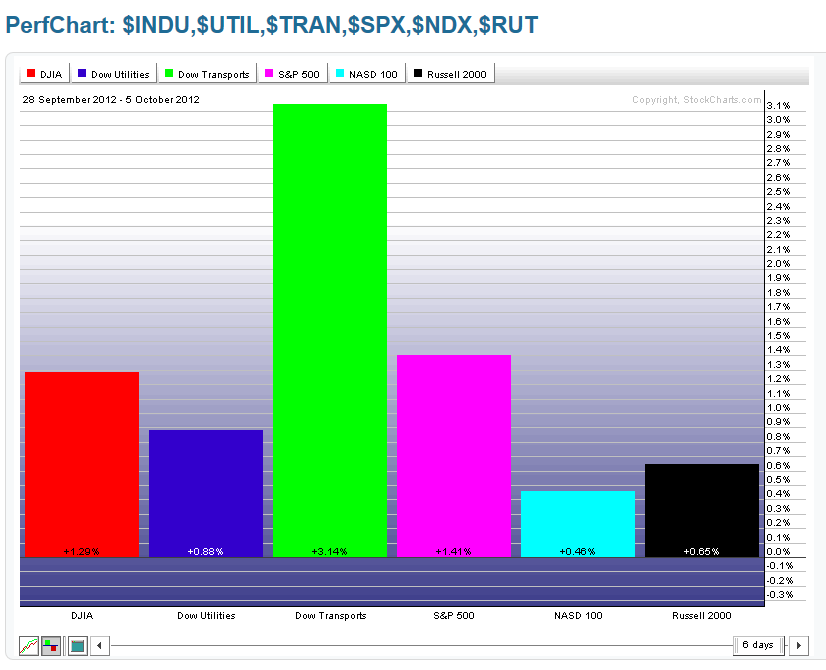
VIX:
The VIX closed up from a triple-bottom bounce (from mid-August), as shown on the Daily chart. It's at lows not seen since 2007, and will need to close and hold above 17.00 to signal that a reversal may be starting on the SPX.
9 Major Sectors:
- All of them, with the exception of the Utilities sector, are in uptrend.
- Above their 20 sma are XLY, XLI, XLB (just), XLP, XLV, and XLF...20 sma = near- term support.
- In between their 20 and 50 smas are XLK and XLE...20 sma = near-term resistance.
- In uptrend and above the rising 20 but falling 50 smas is the XLU...it needs to see the 20 cross and hold above the 50 sma before I'd conclude that it has returned to a full-uptrend status.

As can be seen from the graph below, the Financials were the biggest gainer, followed by Healthcare, and Consumer Staples. Energy and Technology were the smallest gainers and are the ones to watch to see if they regain and hold above their 20 sma.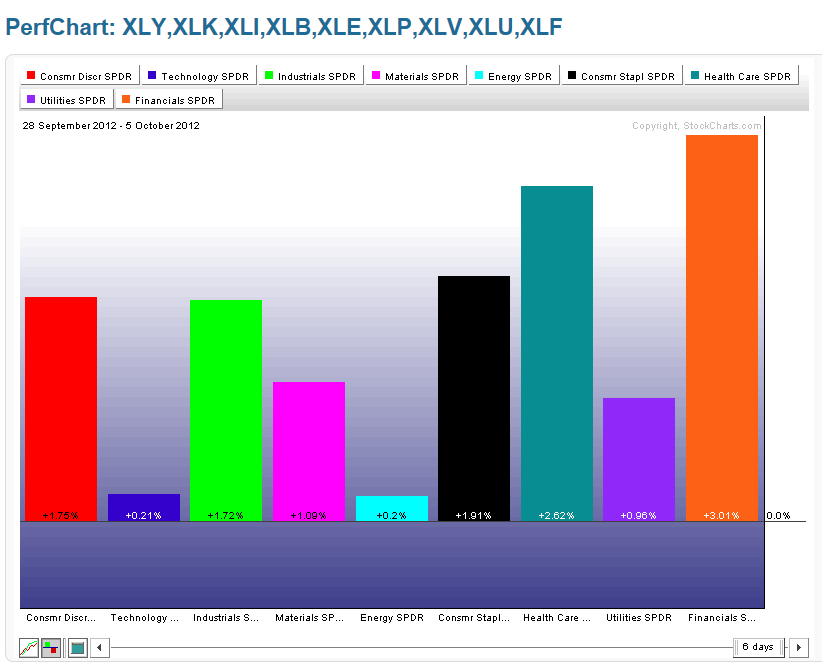
Germany, France and the PIIGS Indices:
They are, generally in uptrend. However, France is the biggest laggard, relative to both smas. France is the one to watch to see if it weakens further, or whether it can make a higher high to continue in uptrend (it made a lower low, so a higher high is necessary next). Greece is the only one that broke and closed above recent highs. 
As can be seen from the graph below, Greece was the largest gainer during the week and is the one to watch for evidence of continued strength. 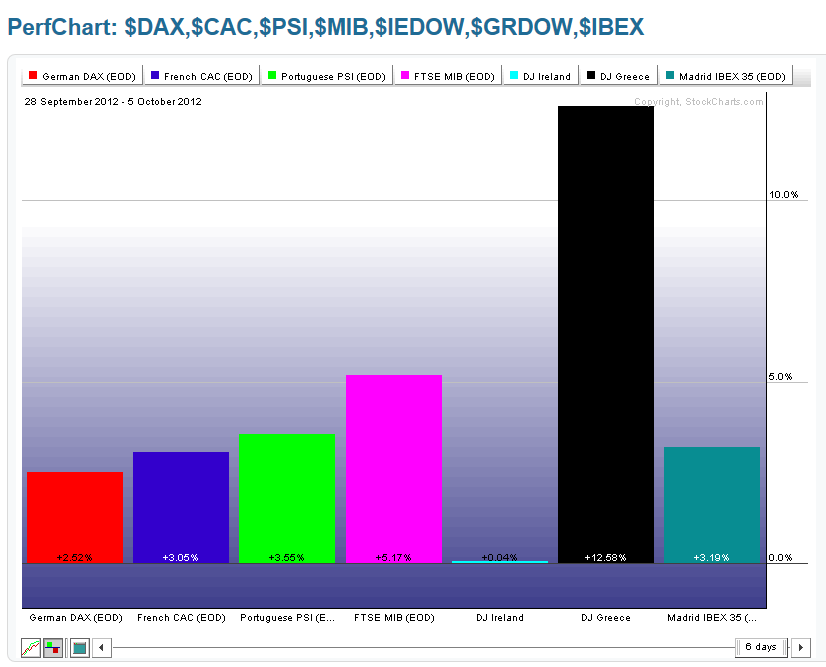
Emerging Markets ETF (EEM) and the BRIC Indices:
With the exception of China, they are, generally, in uptrend. India is the leader of this group and the one to watch for continued strength above its 20 sma. Brazil is lagging and will need to regain and hold above both smas, and Russia will need to regain and hold above the 20 sma. China will need to see the 20 cross and hold above the 50 sma and make a series of higher highs/lows before a reversal of the downtrend can be considered to have begun...it has not yet stabilized and is still in downtrend, with the 50 sma holding as medium-term resistance.
As can be seen from the graph below, Russia was the biggest gainer, followed by EEM and India. Brazil was the loser. China was closed this past week for a holiday.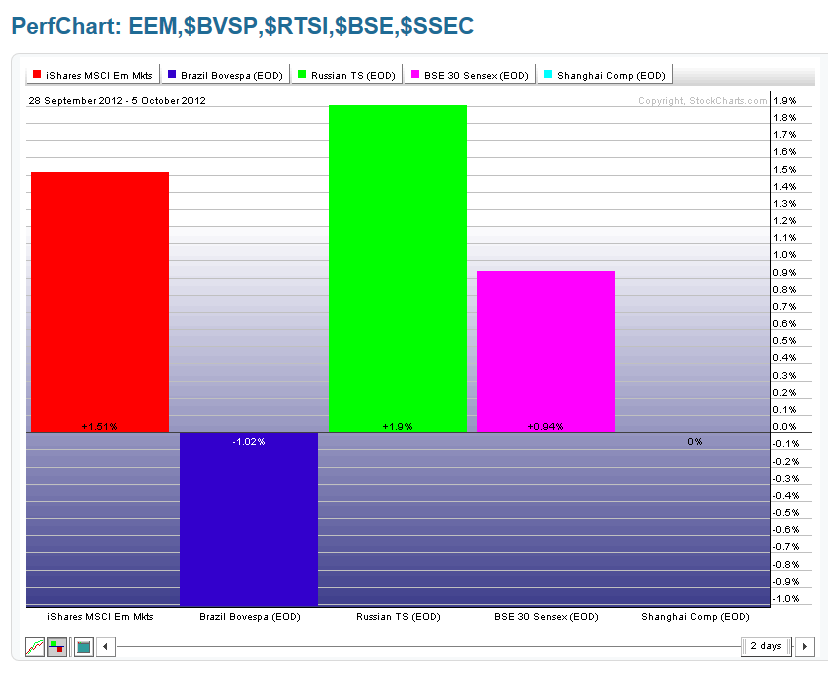
Canada, Japan and World Market Indices:
Canada and the World Market indices are in uptrend, with the 20 sma providing near-term support. Japan is in a slight uptrend, but price is currently below both smas and will need to regain and hold above both before I'd consider it to be in a viable uptrend.
As depicted on the graph below, the largest gainer was the World Market index, followed by Canada. Japan was, basically, flat and will need to firm up, as mentioned above.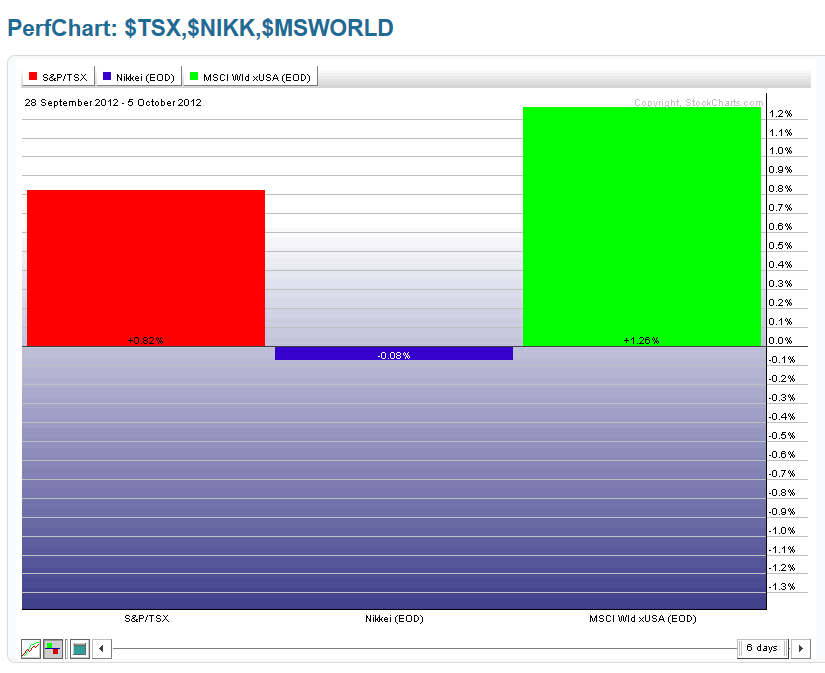
Commodity (DBC) and Agriculture (DBA) ETFs, Gold, Oil, Copper, and Silver:
- DBC is caught in between its 20 and 50 smas...the 50 sma is, essentially at the neckline of a potential Head & Shoulders pattern.
- The 20 has crossed below the 50 sma on DBA, and it is threatening to move into a downtrend...a lower low will confirm that.
- Gold is in uptrend, with the 20 sma serving as near-term support.
- The 20 has crossed below the 50 sma on Oil, and it is in a very tight-ranged downtrend.
- Copper is in uptrend, with the 20 sma serving as near-term support.
- Silver is in uptrend, with the 20 sma serving as near-term support.

As shown on the graph below, Oil was the biggest loser, followed by Agriculture and Commodities...ones to watch for signs of further weakness, which may pull equities down, as well. Gold, Copper, and Silver will need to hold above their respective 20 sma, lest they drop to their 50 sma medium-term support levels.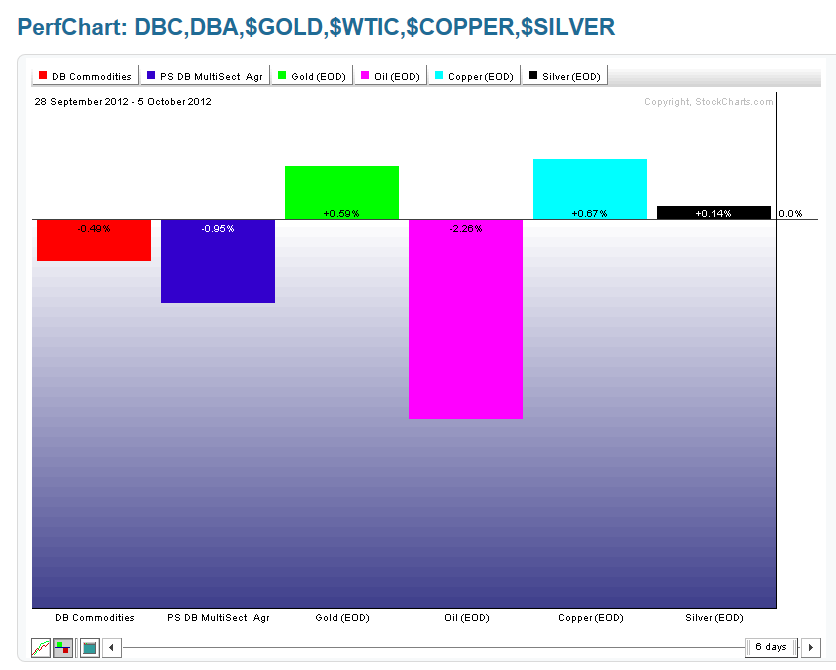
7 Major Currencies:
- The U.S. $ is attempting to stabilize, but has closed just below its 20 sma and is still in downtrend.
- The Euro and Swiss Franc were the only two that closed above their 20 sma and are still in uptrend.
- The Canadian $ closed just below its 20 sma, but is still in uptrend. It will need to regain and hold above the 20 sma to resume its uptrend; otherwise, we may see it drop and hold below the 50 sma. If Canada's Index drops further, along with Oil and Gold, the Canadian $ will likely follow suit.
- The Aussie $ has had a couple of large swings below both smas and is now threatening to make a lower low and send it into downtrend. The 20 has crossed below the 50 sma, as well.
- The British Pound is still in uptrend, but closed below its 20 sma. It will need to regain and hold above the 20 sma to resume its uptrend; otherwise, we may see it drop to its 50 sma.
- The Japanese Yen has not made a higher high and will need to in order to resume its uptrend.
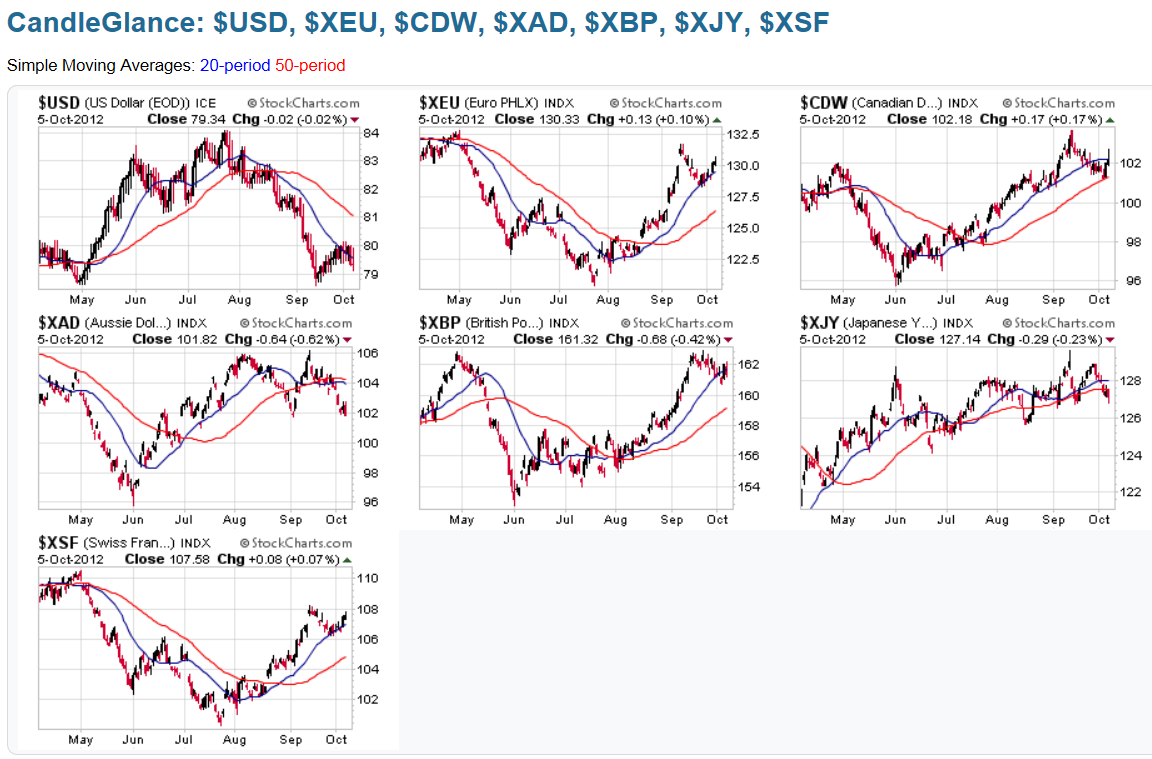
As shown on the graph below, the Aussie $ was the biggest loser this past week, followed by the Yen and U.S. $. The Euro was the biggest gainer, followed by the Swiss Franc, and Canadian $. What happens with the Greek and French indices next week may have a bearing on the Euro in the short term.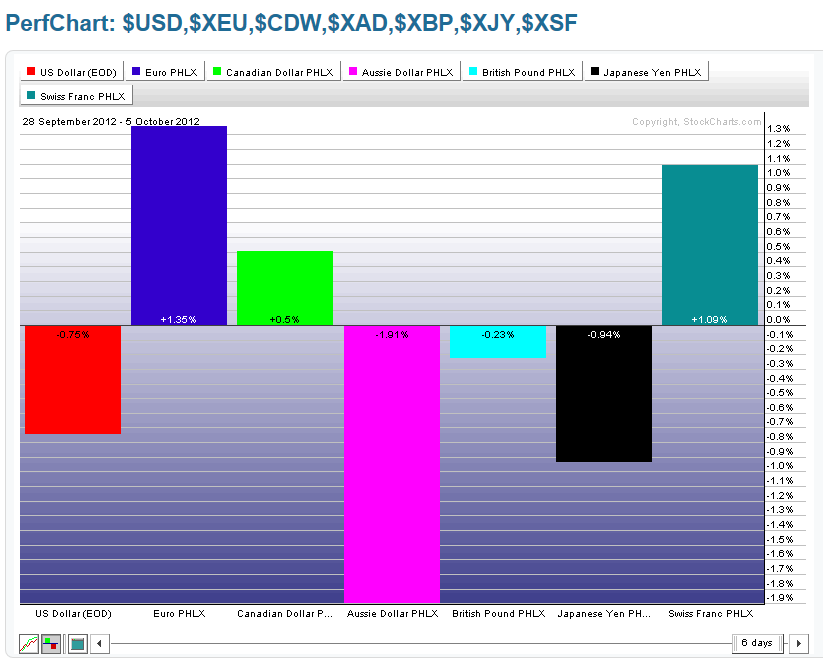
As an addendum to the above currencies, a resolution of China's downtrend will need to take place soon, lest we see the AUD/CAD forex pair continue downward, as mentioned in my earlier post on Friday. I would note that price closed below the neckline of a large potential Head & Shoulders pattern on its Weekly chart at 0.9969. The measured move target of 700 pips would, ultimately, take price down to 0.93.
In summary, China's Shanghai Index and AUD/CAD are important instruments to watch next week, along with the Nasdaq 100, Russell 2000, Financials ETF (XLF), France, Greece, India, Brazil, Canada, Japan, Commodities ETF (DBC), Agriculture ETF (DBA), Gold, Oil, Copper, Silver, U.S. $, Euro, Aussie $, and Canadian $.
